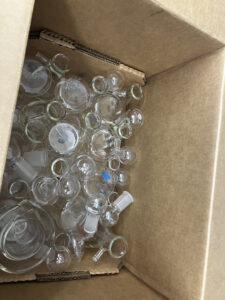In the lab this week we started with continuing our substrate scope to find the most effective compound in our reactions. On Monday we ran three more heat plate reactions. These reactions take around 3 hours to complete, two hours for on the plate and about an hour weighing the reactants out and generally setting up the reactions. The difference between these reactions is the starting material. Each one has a different chemical compound that we are testing. Once we work them up, we are able to filter them through silica and cotton to get a liquid product. Then a Rotavap and an NMR will reveal whether they were successful in creating a high yield.
Before purifying those reactions, our lab had a “heist’ to do. An Industrial chemistry lab in the area was shutting down its San Diego branch, so they reached out to Scripps to offer any equipment that we might want, otherwise it would have been just thrown away. So a couple people from the lab and I went over to see what they had. It was very cool to see what an industrial lab looks like compared to our research lab. While in our lab there are only 8 hoods and workbenches, this lab had an entire building full of only workstations. We ended up getting a couple boxes of glassware that the lab needed so it was a successful trip.
After our field trip we had to purify the crude reactions with Prep TLC (Thin Layer Chromatography) by dotting them along a plate of silica powder. Then lay it in a mix of hexanes and ethyl acetate so that the different components separate up the plate. One of them in particular was very pretty to look at because it had interesting colors.
This week was my second to last in the Engle Lab. I’m sad that I only have a week left to continue learning all about this chemistry from my mentor, but I am so thankful for this opportunity. See you next week!



There are no comments published yet.